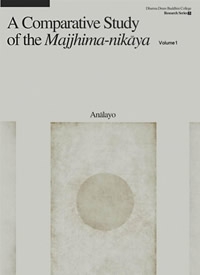商品圖片
A Comparative Study of the Majjhima-nikāya Vol.1 Vol.2
中部尼柯耶比較研究第一冊 第二冊
作者:Anālayo
出版社:法鼓文化
出版日期:2011年07月01日
語言:英文
系列別:法鼓佛教學院論叢
規格:19x26 cm / 平裝 / 1112頁 / 單色印刷
商品編號:1111270031
ISBN:9789575985585
定價:NT$1500
會員價:NT$1,275 (85折)
序/後記
< 回商品頁Dharma Drum Buddhist College Series
↑TOP
Dharma Drum Buddhist College Series
In 1994, Master Sheng Yen (1931–2009), the founder of Dharma Drum Buddhist College, began publishing the Series of the Chung-Hwa Institute of Buddhist Studies.
The purposes of publishing this series were: to provide a venue for academic research in Buddhist Studies supported by scholarships from the Chung-Hwa Institute of Buddhist Studies; to encourage top-quality Buddhist research; and to cultivate an interest in Buddhist research among the readership of the series. Moreover, by encouraging cooperation with international research institutions, he hoped to promote the domestic status of the academic study of Buddhism.
In keeping with Master Sheng Yen’s vision, in order to promote different aspects of exchange in academic research, we at Dharma Drum Buddhist College have begun to publish three educational series:
Dharma Drum Buddhist College Research Series (DDBC-RS),
Dharma Drum Buddhist College Translation Series (DDBC-TS)
Dharma Drum Buddhist College Special Series (DDBC-SS)
The Research Series (DDBC-RS) is primarily intended as a venue for academic research in the field of Buddhist Studies in general and of Chinese Buddhism in particular. The Translation Series (DDBC-TS) will present English renditions of Chinese canonical works as well as other important works, or else Chinese translations of academic publications on Buddhism that have appeared in European languages or Japanese, etc. The Special Series (DDBC-SS) will accommodate works which require special publication formats. Among our future goals is the extensive development of Buddhist digital publishing and information to adapt to the interactive and hyper-connective environment of the Web 2.0 age. This will allow research outcomes to be quickly shared and evaluated through the participation of individual users, through such media as blogs, shared tagging, wikis, social networks and so on. Our hope is to work towards developing an open environment for academic studies (perhaps called Science 2.0) on Buddhist ulture that will be more collaborative and efficient than traditional academic studies. In this way, Dharma Drum Buddhist College will continue to help foster the availability
of digital resources for Buddhist Studies.
Huimin Bhiksu, President
Dharma Drum Buddhist College
July 2010
In 1994, Master Sheng Yen (1931–2009), the founder of Dharma Drum Buddhist College, began publishing the Series of the Chung-Hwa Institute of Buddhist Studies.
The purposes of publishing this series were: to provide a venue for academic research in Buddhist Studies supported by scholarships from the Chung-Hwa Institute of Buddhist Studies; to encourage top-quality Buddhist research; and to cultivate an interest in Buddhist research among the readership of the series. Moreover, by encouraging cooperation with international research institutions, he hoped to promote the domestic status of the academic study of Buddhism.
In keeping with Master Sheng Yen’s vision, in order to promote different aspects of exchange in academic research, we at Dharma Drum Buddhist College have begun to publish three educational series:
Dharma Drum Buddhist College Research Series (DDBC-RS),
Dharma Drum Buddhist College Translation Series (DDBC-TS)
Dharma Drum Buddhist College Special Series (DDBC-SS)
The Research Series (DDBC-RS) is primarily intended as a venue for academic research in the field of Buddhist Studies in general and of Chinese Buddhism in particular. The Translation Series (DDBC-TS) will present English renditions of Chinese canonical works as well as other important works, or else Chinese translations of academic publications on Buddhism that have appeared in European languages or Japanese, etc. The Special Series (DDBC-SS) will accommodate works which require special publication formats. Among our future goals is the extensive development of Buddhist digital publishing and information to adapt to the interactive and hyper-connective environment of the Web 2.0 age. This will allow research outcomes to be quickly shared and evaluated through the participation of individual users, through such media as blogs, shared tagging, wikis, social networks and so on. Our hope is to work towards developing an open environment for academic studies (perhaps called Science 2.0) on Buddhist ulture that will be more collaborative and efficient than traditional academic studies. In this way, Dharma Drum Buddhist College will continue to help foster the availability
of digital resources for Buddhist Studies.
Huimin Bhiksu, President
Dharma Drum Buddhist College
July 2010




